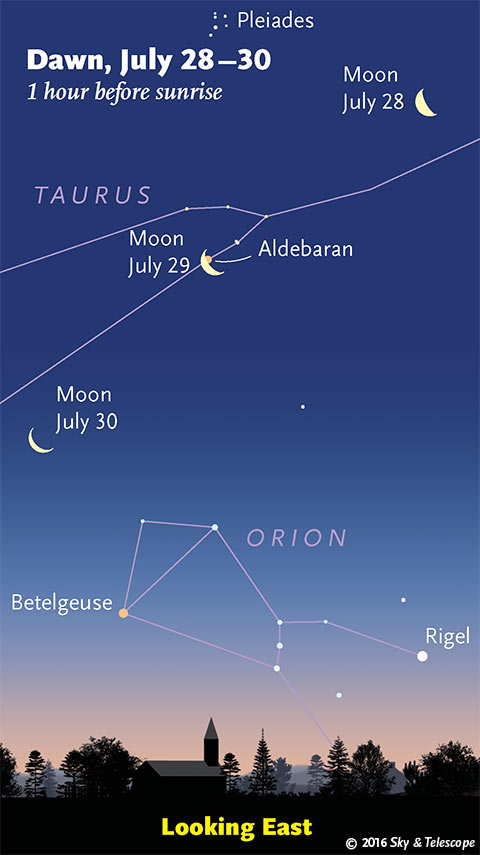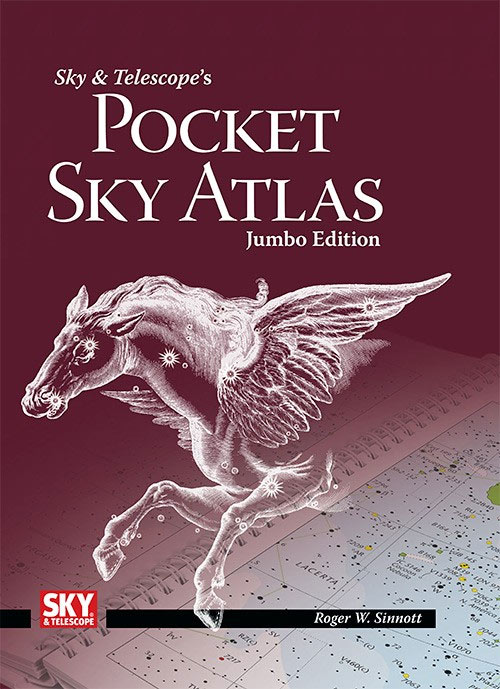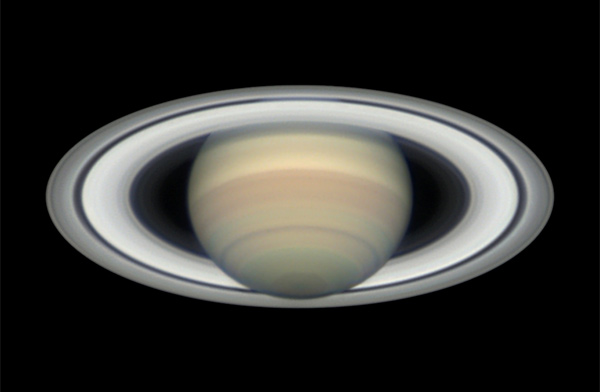This Week’s Sky at a Glance, July 22 – 30

Take a look high in the south before dawn for the waning Moon under the Great Square of Pegasus.
• Starry Scorpius is sometimes called "the Orion of Summer" for its brightness, its blue-giant stars, and its 1st-magnitude red supergiant (Antares). But Scorpius shines a lot lower in the south (for those of us at mid-northern latitudes). That means it has only one really good evening month: July.
Catch Scorpius in the south just after dark now, before it starts to tilt lower toward the southwest. It's full of deep-sky objects for binoculars and telescopes. Not to mention Mars and Saturn close by!
Saturday, July 23
• After nightfall, Altair shines in the east-southeast. Above it by a finger-width at arm's length is its eternal sidekick, little orange Tarazed. Left of Altair by a bit more than a fist-width is little Delphinus, the Dolphin, leaping leftward away from it.
Sunday, July 24
• The tail of Scorpius lies low due south right after dark. Look for the two stars especially close together in the tail. These are Lambda and fainter Upsilon Scorpii, known as the Cat's Eyes. They're canted at an angle; the cat is tilting his head and winking.
The Cat's Eyes point west (right) by nearly a fist-width toward Mu Scorpii, a much tighter pair known as the Little Cat's Eyes. It takes very sharp vision to resolve Mu without binoculars!
Monday, July 25
• The Delta Aquariid meteor shower, modest but very long-lasting, should most active for the next week or so. Under a very dark sky, you might see a dozen Delta Aquariids per hour between midnight and the first light of dawn. Each morning the light of the waning Moon will present less interference.
Tuesday, July 26
• Last-quarter Moon (exact at 7:00 p.m. EDT). The Moon rises around midnight or 1 a.m. daylight-saving time tonight, far below the stars of Aries. By early dawn Wednesday morning it stands high in the southeast.
• Are you checking the location of Nova Ophiuchi 1998, as described on page 51 of the July Sky & Telescope? It may re-explode to 10th magnitude any year now, and someone will be the first to discover this....
The consolation prize on any night are the five globular clusters in its immediate vicinity, as charted on that page.

Now a waning crescent, the Moon crosses Taurus from the morning of the 28th to 30th. On the 29th it occults Aldebaran for some areas. (In these diagrams, the Moon is always drawn three times its actual apparent size for clarity.)
Wednesday, July 27
• We're not yet halfway through summer, but already W-shaped Cassiopeia, a constellation of fall and winter evenings, is climbing up in the north-northeast as evening grows late. And the Great Square of Pegasus, emblem of fall, comes up to balance on one corner just over the eastern horizon.
By the first light of dawn the Great Square stands very high in the south, almost overhead, as shown above.
Thursday, July 28
• The waning crescent Moon occults Aldebaran for observers in much of eastern North America early Friday morning. It will also occult the fainter, nearby star-pair Theta1 and Theta2 Tauri for some of the region. See your August Sky & Telescope, page 50, or themaps and timetables online for all three occultations.
As seen from the narrow graze line from El Paso, Texas, to Toledo, Ohio, Aldebaran's non-zero angular diameter will be evident to the naked eye as the star graduallyfades in and out multiple times among lunar mountains. See the Sky & Telescopearticle and the detailed material about the graze at occultations.org/aldebaran.
Nearly a month later, on August 25th, the Moon will occult Aldebaran in daylight, as also briefly described in the August Sky & Telescope article.
Friday, July 29
• Bright Vega now passes almost straight overhead around 11 p.m. daylight-saving time, depending on your location. As with all star configurations, you'll see it happening two hours earlier every month.
Saturday, July 30
• As summer proceeds, Scorpius shifts westward from its highest stance in the south just after dark, and Sagittarius moves in from the east to take its place. So we're entering prime time for the profusion of Messier objects in and above Sagittarius. How many can you locate with binoculars?
Start with M8, the big Lagoon Nebula. It's 6° above the spout-tip of the Sagittarius Teapot.
_________________________
Want to become a better astronomer? Learn your way around the constellations! They're the key to locating everything fainter and deeper to hunt with binoculars or a telescope.
This is an outdoor nature hobby. For an easy-to-use constellation guide covering the whole evening sky, use the big monthly map in the center of each issue of Sky & Telescope, the essential guide to astronomy.

The Pocket Sky Atlas plots 30,796 stars to magnitude 7.6 — which may sound like a lot, but it's less than one per square degree on the sky. Also plotted are many hundreds of telescopic galaxies, star clusters, and nebulae. Shown above is the new Jumbo Edition for easier reading in the night. Click image for larger view.
Once you get a telescope, to put it to good use you'll need a detailed, large-scale sky atlas (set of charts). The basic standard is the Pocket Sky Atlas(in either the original or new Jumbo Edition), which shows stars to magnitude 7.6.
Next up is the larger and deeper Sky Atlas 2000.0, plotting stars to magnitude 8.5, nearly three times as many. The next up, once you know your way around, is the even larger Uranometria 2000.0(stars to magnitude 9.75). And read how to use sky charts with a telescope.
You'll also want a good deep-sky guidebook, such as Sue French's Deep-Sky Wonders collection (which includes its own charts), Sky Atlas 2000.0 Companion by Strong and Sinnott, or the biggerNight Sky Observer's Guide by Kepple and Sanner.
Can a computerized telescope replace charts?Not for beginners, I don't think, and not on mounts and tripods that are less than top-quality mechanically (meaning heavy and expensive). And as Terence Dickinson and Alan Dyer say in theirBackyard Astronomer's Guide, "A full appreciation of the universe cannot come without developing the skills to find things in the sky and understanding how the sky works. This knowledge comes only by spending time under the stars with star maps in hand."
This Week's Planet Roundup

Two days after Saturn's June 3rd opposition, Damian Peach took this image showing the Seeliger effect: the brightening of the rings with respect to the globe when the sunlight illuminating Saturn comes from almost exactly behind us. This extremely sharp image unambiguously shows the Encke Gap just inside the edge of the outer A ring, and the dusky C ring both against the globe and against the dark-sky background. The rings, practically at their widest open, extend above and below Saturn's south and north poles this season. South is up. The North Polar Hexagon's shape is clearly evident.
Mercury and Venus are very low in bright twilight. About 15 minutes after sunset, use binoculars or a wide-field telescope to start scanning for Venus just above the west-northwest horizon. Venus is magnitude –3.9; Mercury is about magnitude –0.5 (1/25 as bright), and it's fading. Look for it to Venus's upper left; they're 4° apart on July 22 and 7° by July 29.
On the 29th Mercury is about 1° to the right of Regulus, even fainter at magnitude +1.4. Good luck.
Mars (magnitude –0.9, in Libra to the right of upper Scorpius) is still bright, though fading. It's the yellow-orange light in the south-southwest at dusk, and lower in the southwest later in the evening. In a telescope, Mars is still about 13.5 arcseconds in diameter and very plainly gibbous.
Jupiter (magnitude –1.8, between Leo and Virgo) is low due west in twilight. It sets around twilight's end.
Saturn (magnitude +0.2, in southern Ophiuchus) shines in the south 6° above fainter Antares at dusk, and about 13° upper left of brighter Mars. Near the middle of the Mars-Saturn-Antares triangle is the strange variable Delta Scorpii (Dschubba), the middle star of the nearly vertical row marking the Scorpion's head.
See our telescopic guide to Saturn in the June Sky & Telescope, page 48.
Uranus (magnitude 5.8, in Pisces) and Neptune (magnitude 7.8, in Aquarius) are very high in the southeast to south before the first light of dawn. Background and finder charts.
__________________________
All descriptions that relate to your horizon — including the words up, down, right, and left — are written for the world's mid-northern latitudes. Descriptions that also depend on longitude (mainly Moon positions) are for North America.
Eastern Daylight Time (EDT) is Universal Time (UT, UTC, or GMT) minus 4 hours.
__________________________
“This adventure is made possible by generations of searchers strictly adhering to a simple set of rules. Test ideas by experiments and observations. Build on those ideas that pass the test. Reject the ones that fail. Follow the evidence wherever it leads, and question everything. Accept these terms, and the cosmos is yours.”
— Neil deGrasse Tyson
No comments:
Post a Comment